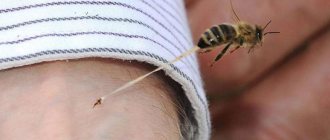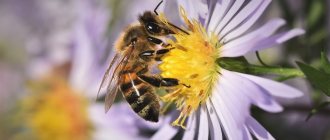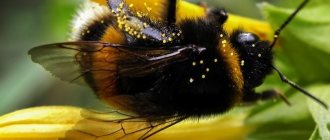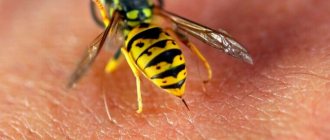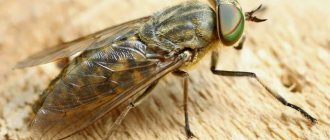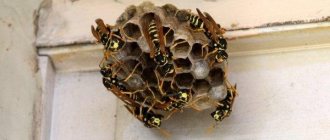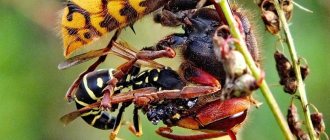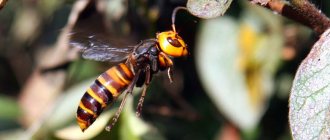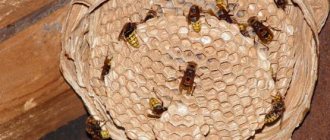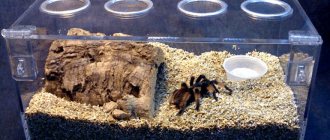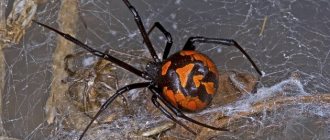A bee is a quite useful insect that produces wax, honey, and propolis. However, despite its benefits, many people are afraid of it. The reason for this is a bee sting.
Bees are not the only insects that bite humans. There are many others that harm humans, such as wasps, bumblebees, house ants, cockroaches and bedbugs. But today we will talk about bees.
To prevent undesirable consequences after a bee sting, you need to have an idea of how dangerous it is, what the body’s reactions may be and how to act in such a situation.
Why does a bee die after being stung?
The bee has a sting located at the end of its abdomen. It is used as a defense and releases poison when bitten. The sting can be used repeatedly to protect against other insects. But a bee can only bite an animal or a person once - then it dies.
Why does a bee die after a human attack? If a bee attacks a person or animal, then it is not able to pull the sting back, so the barbs on it get caught in the soft skin. To free itself, the bee makes sharp jerks. Having pulled out the sting, part of the intestine remains, causing the insect to die.
Why can't you kill a bee if it stings or attacks you?
If you kill a bee, its body releases a certain substance that acts as a military alarm: other bees will flock to you.
Prevention
To avoid bee stings, you need to follow simple recommendations:
- If a bee flies very close, you should not try to drive it away. It is important to remain calm and not make sudden movements until the insect flies away.
- Experts do not advise being afraid of bees. Many scientists claim that insects sense how adrenaline is produced.
- Don't wear bright clothes that attract bees.
- It is not recommended to use perfumes and deodorants that have strong odors. They attract insects.
- You should not walk barefoot on the grass.
Bee stings can pose a real danger to human health and life. Therefore, it is important to provide first aid to the victim in a timely manner. If allergy symptoms appear, a person must be immediately taken to a medical facility.
The danger of a bee sting
A bee sting is harmful and dangerous due to the composition of the substances included in it:
- Melitin is the basic toxin of the poison, destroys red blood cells, increases vascular permeability, releases substances that stimulate inflammation, disrupts metabolic interstitial processes, and causes muscle contractions.
- Apamin - acts on nerve cells, increases motor activity, and has a stimulating effect on spinal cells.
- Histamine protein - releases histamine from mast cells and is the main substance in allergic reactions.
- Histamine – causes pain, swelling, redness, dilates blood vessels.
- Hyaluronidase - spreads venom from the bite point to adjacent tissues.
- Phospholipase A - increases the inflammatory process and damages blood cells.
- Minimin is a highly active peptide.
When a bee stings, two reactions of the human body occur:
- normal (toxic)
- allergic (insect allergy)
The way a person reacts determines what first aid is provided. Depending on the amount of poison entering the body, reactions are divided into groups.
Reactions of the first type - ordinary - are of the following types:
- encephalitis
- malignant myasthenia gravis
- mononeuritis
Reactions of the second type - allergic - are especially harmful and have 3 degrees:
I degree of reaction and symptoms accompanying it:
- slight chills
- angioneurotic tumor (Quincke's edema)
- hives
- elevated body temperature
- nausea, vomiting
- headache
II degree of reaction (moderate severity) and its symptoms:
- heart rhythm disorder
- swelling of the mucous membranes
- spasms of the bronchial muscles
III degree of reaction (severe) and its symptoms:
Anaphylactic shock (without medical assistance, death is possible).
Pathogenesis
Bees have sharp stings that are located on the abdomen - at its rear end. The insect injects poison through its sting, which causes pain, irritation, and sometimes allergic reactions. Unlike other insects, bees leave a sting in the wound. The sting can gradually go deeper on its own and at the same time release poison. That is why it needs to be removed as soon as possible.
Bee venom contains phospholipase A , which produces a hemolyzing effect. red blood cells disintegrate at the site of exposure . Melittin is a linear polypeptide that has toxic effects. Under its influence, edema forms, blood vessels become more permeable, convulsions and coronary disorders develop. Apamin is a powerful neurotoxin that affects the bulbar centers as well as the spinal cord. It may depress breathing. However, if a person is bitten by one insect, then the concentration of the substance is not sufficient to cause pronounced pathological reactions. But with multiple bites, the reaction can be pronounced.
If an allergic reaction develops, it can occur in the form of anaphylactic shock , angioedema, or urticaria .
First aid for a bite
Help with a bee sting should be carried out in the following order.
Removing the sting
After a bee sting, you must carefully remove the sting (without touching the sac of poison) remaining in the skin. It's best to use tweezers here. You must first treat the instrument with alcohol or a disinfectant.
You must not squeeze out the sting, otherwise the poison will spread throughout the body faster!
Neutralization of bee venom
Neutralize the poison with a soap solution. Why soap solution? Bee venom has an acidic pH, so it can be neutralized with an alkaline solution, in this case soap.
Disinfection
Treat the arm, leg, or other bite site with hydrogen peroxide, a solution of ammonia (it can also relieve swelling) or potassium permanganate, or alcohol tincture of calendula.
A swelling from a wasp sting can be removed with solutions of soda or salt. One of the main signs of a bedbug bite is a puncture mark. You will find a description of other symptoms in this article.
The Colorado potato beetle is a serious pest of potatoes, tomatoes and eggplants. Read the link for a detailed description of the insect.
Elimination of pain, itching, swelling
To relieve pain, use a cold compress (ice wrapped in a towel, for example). There is great benefit from medications and ointments with an antihistamine effect. For example, “Suprastin”, “Diphenhydramine”, “Fenistil”, etc. They can relieve symptoms.
It is also important to know that you should not scratch the tumor after a bee sting, as this contributes to the faster spread of poison throughout the body.
Tests and diagnostics
Bee sting photo
It is usually possible to determine that a person has been bitten by a bee visually. But if we are talking about severe allergic reactions, then you have to call emergency help, whose doctors will examine you and make a preliminary diagnosis.
If necessary, if a person develops severe reactions, additional examinations are carried out.
- Physical blood pressure are measured . The doctor examines the skin to determine whether there are signs of allergies . Listening to the lungs may be performed.
- Laboratory - a general blood test is performed to determine signs of the inflammatory process
- Hardware - its use is advisable only in the development of pronounced systemic manifestations. Ultrasound, radiography, and ECG are used.
What to do if the victim has an insect allergy
Particularly harmful are cases where there is an allergy to a bee sting.
Help with a bee sting and what you can do:
- Call the doctors
- Remove sting
- Treat the wound with an antiseptic and apply a cold compress (the cold can be kept for 4 hours, no more) to prevent swelling
- Take an antihistamine
Many people believe that it is enough for an allergic person to administer epinephrine and the reaction will stop. But there are times when this is not enough and the knowledge of a doctor is required. Do not rely only on the case of “As usual” and if you are allergic to a bee sting, call an ambulance.
Help provided by doctors:
- The first thing doctors will do is to carry out a circular infiltration blockade with novocaine and use forced diuresis with alkalization of the blood
- Administration of calcium chloride or gluconate, ascorbic acid, prednisolone and antihistamines
- Hospitalization for subsequent inpatient treatment
Terror that flies on the wings of the night
The carpenter bee, also known as Xylocopa, Greater Tree Bee, Carpenter Bee, Black Bee or Tree Nest Bee (Xylocopa) is a genus of solitary bees in the family Apidae, widely distributed on several continents. They differ from ordinary honey bees in the dark color of the body and wings, larger (20-30 mm) body size and very low aggressiveness.
Xylocopa violacea. In the UK it is called Violet carpenter bee, literally corresponds to the Russian name
Science knows about half a thousand species of carpenter bees, most of which are grouped into 30-35 subgenera, some of which are monophylithic (i.e., include only one species). In Russia and the CIS countries, from April to September, mainly the common carpenter bee (Xylocopa valga) and the purple carpenter bee (Xylocopa violacea) are found.
In Germany it is called Große Blaue Holzbiene, or Blauschwarze, and also Violettflügelige Holzbiene. Large blue wood bee, also blue black or purple bee respectively. Photo: Thomas Steg
Carpenter bees are cosmopolitan. Their range also covers the territory from Western Europe to Central Asia. Common in Ukraine and southern Russia. In recent decades, the appearance of carpenter bees north of the Rostov region has become increasingly frequent. Individual bees were spotted in the Urals and in the Northwestern District.
Favorite delicacies include acacia nectar, linden, clover, fruit crops, and sunflower. However, she is not averse to eating other flowers.
Its large size, dense build and large darkly colored wings allow it to cover long distances even in bad weather. The dark pigment in the wing tissues gives them additional strength, and the glossy shine in some species reflects the heat rays of the Sun, saving the bee from overheating.
Xylocops are solitary bees. This means that they do not build hives, and do not form a strict hierarchy with the queen. Each bee is an independent unit: it provides itself with food and shelter, and independently cares for its offspring. Several weeks - after which it leaves the larvae to their fate. The male is only needed for fertilization - his life span barely exceeds two weeks.
The carpenter bee got its name from the specific way it constructs its nest. The adult female first of all looks for a suitable piece of soft wood, and for some species it is not particularly important whether it is a living tree or part of a building. Sometimes you can find bee “holes” in your fence or window frame.
At the same time, the bee literally gnaws its way with its powerful jaws, which is accompanied by a characteristic sound reminiscent of the work of a saw.
When there was a xylocope in the frame of my window, at first I even thought that mice had gotten into us))
In the absence of a tree, a carpenter bee can also use dead parts of a plant with a tubular stem, for example, hogweed, hogweed or burdock. One of the ancient subgenera Proxylocopa actually digs burrows right in the damp ground.
Each move the bee divides by partitions into 8-12 cells. The number of these cells and the branching of the course depends on the type of bee.
In each cell, the xylocop places a lump of collected pollen, moistened with nectar and glued together with the saliva of the bee itself. It lays one egg in a sweet pie. One lump is food for the larva for the entire growth period, so the bee collects sooooo much pollen and nectar. To collect pollen, it has special pollen folds and passages in the shell. And to collect nectar, she sometimes gnaws through flowers with a long corolla, literally sucking out every last drop.
Why bother trying to get a drop of nectar if you can take a bite and drink it all down?)) Photo: Alvesgaspar
After this, each cell is walled up with an adhesive mass of bee saliva and sawdust, leaving only air access. The mother bee guards her nest for two to three weeks, after which she goes on a journey. The larvae grow all summer, pupate in August-September, and become adults in the fall. They come out only in early spring, gnawing through partitions. An adult bee overwinters, seeking shelter in the form of empty nests, sawfly passages, abandoned hives and crevices in trees and wooden buildings.
Usually one bee from the new generation remains in the nest. So several generations of bees can live in one nest.
Black carpenter bee having lunch. Photo: Bautsch
Are carpenter bees dangerous?
By themselves, no. An adult tree bee is not aggressive; it does not attack people or animals unless you try to catch it or damage the nest. Moreover, until recently, carpenter bees were listed in the Red Book of Russia and Ukraine as a species whose existence is under threat. The reduction in their numbers was facilitated by the active cutting down of broad-leaved forests, as well as the massive treatment of fields with insecticides during the late USSR. Now their numbers are recovering, and their range is expanding to the north and east.
"Who are you? I didn’t call you!”
The sting of a carpenter bee (or rather, a sting - bees do not tend to bite at all))) is stronger and more painful than that of a honey bee, and causes about the same harm - the glands at the base of the sting contain poison, causing painful swelling. For a healthy person this will only cause discomfort, while for people with allergies it can cause a severe reaction, itching, ulceration and Quincke's edema.
However, it is not because of the stings that some summer residents disliked tree bees. When colonizing wooden buildings and supports, bees gnaw long passages. And if in fresh wood one nest does not create any problems (more on this below), then in old wood it can be the last straw. Adding to this the attachment of bees to one place for many generations, as well as all kinds of wood bugs, you can get a beam dotted with passages.
“Don’t bully me here. My great-grandmother built a nest here!”
In addition, the bee can bring with it fungal spores, which will sprout mold literally from inside the tree. Empty nests become shelters for other bees, wasps, as well as nests of grinders and other insects.
To get rid of them, summer residents build special traps and also use special insecticides.
Trap. So, before the species had time to recover, they were exterminated again.
So, the carpenter bee is a very interesting representative of the family. Peaceful carpenter bees usually do not cause problems if left undisturbed. But they delight the eye with their brilliant color.
This is not photoshop. This is Xylocopa caerulea, a blue carpenter bee native to southern Russia. And there is also a diamond and emerald carpenter bee, however, already in Australia)
All the best and don’t get sick!
PS The article was written by biotechnologist Lyudmila Khigerovich and published in the scientific community by Phaneroza. The article relates to the topics of biology hubs, popular science, reading room and is thematic , although this will not stop dislikers...
Sources
Panfilov D. V., Berezin M. V. CARPENTER BEE - Xylocopa valga Gerstaecker, 1872
Barbara Thomas und Rolf Witt (2005): Erstnachweis der Holzbiene Xylocopa violacea (Linné 1758) in Niedersachsen und weitere Vorkommen am nordwestlichen Arealrand (Hymenoptera: Apidae). Drosera 2005: 89-96.
Bee is a carpenter. Agro story portal [electronic resource] URL: https://agrostory.com/info-centre/knowledge-lab/pchela-plotnik/
Lyudmila Svetlitskaya. Carpenter bees - why are they dangerous and how to get rid of them? Portal “Botanichka.ru” [electronic resource] URL: https://www.botanichka.ru/article/pchelyi-plotniki-chem-opasnyi-i-kak-ot-nih-izbavitsya/
Elena Miroshnichenko. How does a drill work? What kind of nests does a carpenter bee build? Belgorod news (official website of BelPress) [electronic resource] URL: https://www.belpressa.ru/society/drugoe/32565.html
Folk remedies for treating a bite
- Aspirin and activated carbon are excellent absorbents of various poisons. When combined with aspirin, it can treat pain and itching. Dissolve one tablet in a glass of water and apply cotton wool soaked in this solution to the desired location.
- Parsley - this plant produces a good anti-inflammatory effect and is beneficial. Apply parsley leaves brewed in boiling water or crushed to the stung hand, leg, etc. The plant treats redness, swelling and pain. You can add plantain leaves to parsley, which help speed up wound healing.
- Olive oil - can relieve redness and irritation. Unsaturated fatty acids in the oil have a regenerating and nourishing effect on the skin.
- Onion juice contains substances that bind the components of bee venom. Helps relieve pain, redness and reduce swelling.
- Aloe has numerous medicinal properties. The diluted juice of the plant is used as a compress. Aloe treats itching, hives, swelling.
Never apply soil when bitten, as traditional medicine advises! This will not relieve pain and may lead to infection.
Diet
Hypoallergenic diet
- Efficacy: therapeutic effect after 21-40 days
- Timing: constantly
- Cost of products: 1300-1400 rubles. in Week
If a person is stung by an insect, he should be sure to consume a sufficient amount of fluid. You need to drink clean water, as well as weak tea, fruit drinks, and compotes.
Nutrition should be healthy and nutritious. If a person has a tendency to allergies, foods that provoke allergic reactions should be excluded from the menu.
Where can you find insects
© Getty Images Pro
Bees
live in large families in hives. They are most often found near flowers, but they also like to live in hollow trees, abandoned rodent burrows, wooden objects and roofs.
bumblebees
They live in small families, usually on the ground or in empty bird nests.
Wasps
They live in families, usually on the ground or under roof space, and their nests can often be found in places such as gutters, bushes and areas along fences. Wasps love meat, so if you barbecue, they may fly onto the meat.
Hornets nests
can be on trees, bushes, hanging from eaves and even poles. Since they are a type of wasp, they also love meat.
